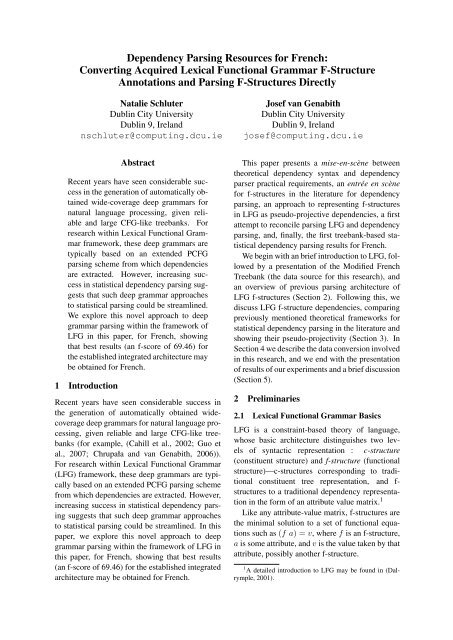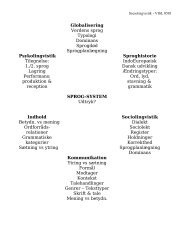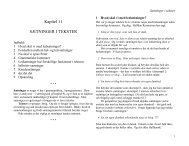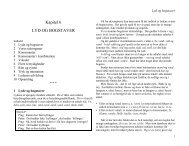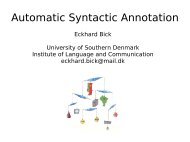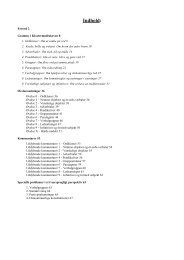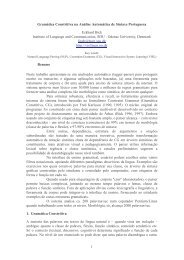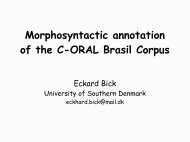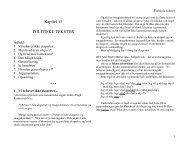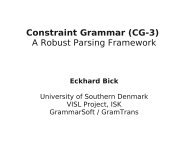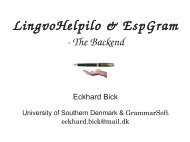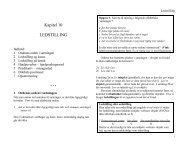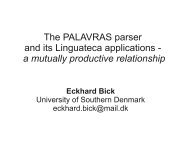Converting Acquired Lexical Functional Grammar F-Structure ... - VISL
Converting Acquired Lexical Functional Grammar F-Structure ... - VISL
Converting Acquired Lexical Functional Grammar F-Structure ... - VISL
Create successful ePaper yourself
Turn your PDF publications into a flip-book with our unique Google optimized e-Paper software.
Dependency Parsing Resources for French:<br />
<strong>Converting</strong> <strong>Acquired</strong> <strong>Lexical</strong> <strong>Functional</strong> <strong>Grammar</strong> F-<strong>Structure</strong><br />
Annotations and Parsing F-<strong>Structure</strong>s Directly<br />
Natalie Schluter<br />
Dublin City University<br />
Dublin 9, Ireland<br />
nschluter@computing.dcu.ie<br />
Abstract<br />
Recent years have seen considerable success<br />
in the generation of automatically obtained<br />
wide-coverage deep grammars for<br />
natural language processing, given reliable<br />
and large CFG-like treebanks. For<br />
research within <strong>Lexical</strong> <strong>Functional</strong> <strong>Grammar</strong><br />
framework, these deep grammars are<br />
typically based on an extended PCFG<br />
parsing scheme from which dependencies<br />
are extracted. However, increasing success<br />
in statistical dependency parsing suggests<br />
that such deep grammar approaches<br />
to statistical parsing could be streamlined.<br />
We explore this novel approach to deep<br />
grammar parsing within the framework of<br />
LFG in this paper, for French, showing<br />
that best results (an f-score of 69.46) for<br />
the established integrated architecture may<br />
be obtained for French.<br />
1 Introduction<br />
Recent years have seen considerable success in<br />
the generation of automatically obtained widecoverage<br />
deep grammars for natural language processing,<br />
given reliable and large CFG-like treebanks<br />
(for example, (Cahill et al., 2002; Guo et<br />
al., 2007; Chrupała and van Genabith, 2006)).<br />
For research within <strong>Lexical</strong> <strong>Functional</strong> <strong>Grammar</strong><br />
(LFG) framework, these deep grammars are typically<br />
based on an extended PCFG parsing scheme<br />
from which dependencies are extracted. However,<br />
increasing success in statistical dependency parsing<br />
suggests that such deep grammar approaches<br />
to statistical parsing could be streamlined. In this<br />
paper, we explore this novel approach to deep<br />
grammar parsing within the framework of LFG in<br />
this paper, for French, showing that best results<br />
(an f-score of 69.46) for the established integrated<br />
architecture may be obtained for French.<br />
Josef van Genabith<br />
Dublin City University<br />
Dublin 9, Ireland<br />
josef@computing.dcu.ie<br />
This paper presents a mise-en-scène between<br />
theoretical dependency syntax and dependency<br />
parser practical requirements, an entrée en scène<br />
for f-structures in the literature for dependency<br />
parsing, an approach to representing f-structures<br />
in LFG as pseudo-projective dependencies, a first<br />
attempt to reconcile parsing LFG and dependency<br />
parsing, and, finally, the first treebank-based statistical<br />
dependency parsing results for French.<br />
We begin with an brief introduction to LFG, followed<br />
by a presentation of the Modified French<br />
Treebank (the data source for this research), and<br />
an overview of previous parsing architecture of<br />
LFG f-structures (Section 2). Following this, we<br />
discuss LFG f-structure dependencies, comparing<br />
previously mentioned theoretical frameworks for<br />
statistical dependency parsing in the literature and<br />
showing their pseudo-projectivity (Section 3). In<br />
Section 4 we describe the data conversion involved<br />
in this research, and we end with the presentation<br />
of results of our experiments and a brief discussion<br />
(Section 5).<br />
2 Preliminaries<br />
2.1 <strong>Lexical</strong> <strong>Functional</strong> <strong>Grammar</strong> Basics<br />
LFG is a constraint-based theory of language,<br />
whose basic architecture distinguishes two levels<br />
of syntactic representation : c-structure<br />
(constituent structure) and f-structure (functional<br />
structure)—c-structures corresponding to traditional<br />
constituent tree representation, and fstructures<br />
to a traditional dependency representation<br />
in the form of an attribute value matrix. 1<br />
Like any attribute-value matrix, f-structures are<br />
the minimal solution to a set of functional equations<br />
such as (f a) = v, where f is an f-structure,<br />
a is some attribute, and v is the value taken by that<br />
attribute, possibly another f-structure.<br />
1 A detailed introduction to LFG may be found in (Dal-<br />
rymple, 2001).
These two levels of representation (f-structure<br />
and c-structure), for a given phrase, are explicitly<br />
related by a structural mapping, called the fdescription,<br />
often denoted by φ, which maps cstructure<br />
nodes to f-structure nodes.<br />
In the LFG framework, this mapping may be<br />
given by functional annotations inserted into the<br />
c-structure tree, as in Figure 1.<br />
S ↑=↓<br />
<br />
NP ↑subj=↓ VP ↑=↓<br />
<br />
<br />
NNP ↑=↓ V ↑=↓ NP ↑obj=↓<br />
John<br />
↑pred=‘John’<br />
helped<br />
↑pred=‘help’<br />
NNP ↑=↓<br />
Mary<br />
↑pred=‘Mary’<br />
Figure 1: Annotated C-structure for John helped<br />
Mary.<br />
The metavariables ↑ and ↓ refer to the fstructure<br />
of the mother node and that of the node<br />
itself, respectively. So that if node n, is annotated<br />
↑=↓, then n’s f-structure is mapped to the<br />
same f-structure as n’s mother’s f-structure. Also,<br />
if n has the annotation ↑obj=↓, this means that<br />
the f-structure associated with n is mapped to the<br />
value of the mother’s f-structure obj attribute.<br />
LFG also has equations for members of sets, such<br />
as ↓∈↑adjunct, which states that the node’s fstructure<br />
is mapped to an element of the mother’s<br />
ADJ attribute.<br />
2.2 Modified French Treebank<br />
For this research, the treebank adopted is the Modified<br />
French Treebank (MFT) (Schluter and van<br />
Genabith, 2007). One important feature of the<br />
MFT is the extended function tag set, which includes<br />
function path tags. Consider the sentence in<br />
Example (1), taken directly from the MFT, whose<br />
tree structure is given in Figure 2.<br />
(1) C’est [...] l’URSS [...] qui se<br />
It is [...] the USSR [...] who herself<br />
trouve prise<br />
finds taken<br />
‘It is the USSR that finds itself trapped’ 2<br />
In this example, the Srel constituent takes the<br />
functional path tag SUJ.MOD, representing the<br />
2 Sentence 8151, file flmf3 08000 08499ep.xd.cat.xml.<br />
SENT<br />
<br />
<br />
VN-SUJ<br />
NP-ATS<br />
Srel-SUJ.MOD<br />
CL Vfinite D N qui se<br />
c’ est l’ URSS<br />
trouve prise<br />
Figure 2: MFT representation of Example (1).<br />
fact that Srel has the function MOD and is dependent<br />
on the constituent whose function is SUJ.<br />
For this research, we followed the same random<br />
partition as (Schluter and van Genabith, 2008) for<br />
the training set (3800 sentences), test set (430 sentences),<br />
and development set (509 sentences).<br />
2.3 Previous Parsing Architectures of LFG<br />
F-<strong>Structure</strong>s<br />
Previously, the technology for treebank-based acquisition<br />
of multilingual LFG probabilistic parsing<br />
resources consisted of three main stages, the basic<br />
input for which is a CFG-type treebank. These<br />
stages include the construction and application of<br />
an f-structure annotation algorithm combined with<br />
satisfiability verification, subcategorisation frame<br />
extraction, and long-distance dependency extraction.<br />
Given the resources produced in these initial<br />
stages, four CFG-based probabilistic parsing<br />
architectures were developed. Figure 3 shows<br />
these parsing architectures, with, in bold grey,<br />
the additional probabilistic dependency-based integrated<br />
architecture that is being presented here.<br />
(For more information on these former CFG-based<br />
probabilistic parsing architectures for French, see<br />
(Schluter and van Genabith, 2008)).<br />
2.3.1 F-<strong>Structure</strong> Annotation Algorithm<br />
For the creation of the dependency bank for<br />
French, to be used as training material, we will use<br />
f-structures. In the LFG framework, f-structures<br />
may be fully specified by f-structure annotated cstructures.<br />
The f-structure annotation algorithm<br />
outlined in (Schluter and van Genabith, 2008) will<br />
be adopted here, to obtain f-structure annotated cstructures.<br />
For French, it uses head-finding principles<br />
for a given constituent, to annotate MFT trees<br />
according to one of four modules:<br />
1. LFG Conversion Module: MFT functional<br />
tags are directly translated into LFG function<br />
equations with respect to the constituent<br />
under consideration. For example, the
Probabilistic<br />
CFG-type<br />
Parsers<br />
CFG trees<br />
Pipeline<br />
Automatic<br />
F-structure<br />
Annotation<br />
(Function Tag)<br />
CFG parsing<br />
model<br />
SVM Function<br />
Tagging<br />
Treebank<br />
annotated<br />
CFG trees<br />
CFG trees<br />
SVM F-<strong>Structure</strong><br />
Equation<br />
Tagging<br />
Constraint Solver<br />
Integrated<br />
Automatic<br />
F-structure<br />
Annotation<br />
f-structure<br />
equation<br />
annotated<br />
CFG<br />
parsing<br />
model<br />
Probabilistic<br />
CFG-type<br />
Parsers<br />
Proto f-structures<br />
F-structure annotated<br />
CFG trees<br />
Probabilistic<br />
Dependency<br />
Parsers<br />
Conversion to<br />
annotated<br />
dependency<br />
treebank<br />
LDD<br />
Resolution<br />
Subcategorisation<br />
Frame, LDD<br />
Extraction<br />
Proper<br />
f-structures<br />
Figure 3: Overview of treebank-based LFG parsing architectures. The proposed dependency-based architecture<br />
being outlined in this paper is in bold grey.<br />
functional tag ATO may be mapped to ↑xcomp=↓,<br />
↑-obj=↓-subj.<br />
2. Right-Left Annotation Module: Constituent<br />
daughters are annotated with respect<br />
to the location of the constituent head. The<br />
constituent head is simply annotated as the<br />
predicate (↑-pred=lemma), or the governor<br />
of the predicate (↑=↓).<br />
3. Verb Combinatorics Module: Combinations<br />
of different verb complexes in the<br />
MFT’s constituent VN are resolved to predicates<br />
with corresponding compound tenses,<br />
for a monoclausal f-structural representation<br />
of verb phrases.<br />
4. Catch-all and Clean-up Module: Any correction<br />
of detected overgeneralisations or<br />
miscellaneous annotations (such as sentence<br />
type) are carried out.<br />
LFG<br />
Conversion<br />
Head-Finding<br />
Principles<br />
Verb<br />
Combinatorics<br />
Core modules<br />
Right-Left<br />
Context<br />
Annotation<br />
Catch-all and<br />
Clean-up<br />
F-structure<br />
Equation Extraction<br />
Coordination<br />
Distribution<br />
Post-processing<br />
Figure 4: French Annotation Algorithm.<br />
The f-structure annotation algorithm French<br />
was evaluated against a hand-corrected gold standard<br />
dependency bank. It achieves 98.4% coverage,<br />
with a best preds-only f-score of 99.63 (Table<br />
1).<br />
coord dist precision recall f-score<br />
no 98.57 96.38 97.46<br />
yes 99.49 99.77 99.63<br />
Table 1: Preds-only f-structure annotation algorithm<br />
performance.<br />
2.3.2 Previous LFG Parsing Results for<br />
French<br />
In this paper, because dependency parsers parse<br />
relations between actual word-forms and not any<br />
other features, we consider only preds-only results<br />
for LFG f-structures. That is, we evaluate only<br />
along those branches of the f-structures that end in<br />
a predicate.<br />
(Schluter and van Genabith, 2008) report parsing<br />
results for both the integrated and pipeline architectures,<br />
with a best preds-only f-score for the<br />
integrated architecture of 67.88. 3<br />
3 LFG F-structure Dependencies<br />
In this section, we overview the different target<br />
frameworks for the conversion of CFG-like data<br />
into dependency tree data (Section 3.1). We then<br />
3 The pipeline architecture outperforms the integrated architecture<br />
in (Schluter and van Genabith, 2008).
consider projectivity in light of these conversions,<br />
and explain why projectivity need not be a problem<br />
in LFG dependency parsing as a result of its<br />
the property of pseudo-projectivity (Section 3.2).<br />
3.1 A Comparison of Theoretical<br />
Frameworks<br />
In the statistical dependency parsing literature,<br />
there are generally two sources of modern linguistic<br />
theoretical justification behind parsing models:<br />
the theoretical framework of the Meaning-<br />
Text Theory (Mel’čuk, 1998), and the annotation<br />
guidelines of the Prague Treebank (Hajič et<br />
al., 1999). Moreover, software converting phrasestructure<br />
style treebanks into dependencies for statistical<br />
dependency parsing usually quote these<br />
two annotation styles in the treatment of hard<br />
cases. Therefore, when statistically parsing LFG<br />
f-structures, it is vital to consider what sorts of dependencies<br />
existing dependency parsers were intended<br />
to parse.<br />
Meaning-Text Theory (MTT) represents the<br />
syntactic organisation of sentences strictly by dependencies.<br />
Under this framework, syntax is separated<br />
into surface and deep syntactic dependencybased<br />
tree representations. The deep-syntactic<br />
structure of a sentence has nodes that are semantically<br />
full lemmata (full lexemes); abstraction is<br />
made of any auxiliary or structural lemmata at<br />
this level. Also, lemmata are subscripted by the<br />
grammatical information (grammemes) expressed<br />
by their associated word-form(s), not imposed by<br />
government and agreement. Arcs are labeled by a<br />
selection of around ten language-independent relations.<br />
On the other hand, the surface-syntactic<br />
structure of a sentence contains all lemmata of the<br />
sentence and its arcs are labeled with the names of<br />
language-specific surface-syntactic relations, each<br />
of which represents a particular construction of<br />
the language (Mel’čuk, 2003; Mel’čuk, 1998).<br />
Furthermore, communicative functions such as<br />
topic or focus are not associated with a pure<br />
syntactic structure in the Meaning-Text Theory<br />
(Mel’čuk, 2001).<br />
The Prague Treebank (PT) annotation guidelines<br />
(Hajič et al., 1999) also distinguishes between<br />
two levels of dependency-based syntactic<br />
representation: analytical and tectogrammatical.<br />
These guidelines are written in the spirit of <strong>Functional</strong><br />
Generative Description. 4 These two levels<br />
4 See, for example, (Hajičová and Sgall, 2003) for a dis-<br />
of syntactic representation roughly correspond to<br />
those of the Meaning-Text Theory—the analytical<br />
level corresponding to the surface-syntax of<br />
the MTT and the tectogrammatical level corresponding<br />
to the deep-syntactic level of the MTT<br />
( ˇZabokrtsk´y, 2005). In the PT, word-forms have<br />
attributes for their lemmata as well as for grammatical<br />
and lexical information expressed morphologically.<br />
The syntactic structure of the treebank<br />
is given for the analytic level of representation,<br />
though work is under way on complementing<br />
this with a tectogrammatical level of representation<br />
(Sgall et al., 2004). Also similarly to<br />
the MTT, communicative structure is not associated<br />
with pure syntax in <strong>Functional</strong> Generative<br />
Description, and therefore does not figure among<br />
annotations defined for the PT.<br />
LFG does not have a uniform dependency syntax,<br />
distinguishing between c-structure and fstructure.<br />
These two systems contain different<br />
sorts of information, represented by means of<br />
phrase-structure trees, for the c-structure, and dependency<br />
dags, for f-structures. The f-structure<br />
is an abstract functional syntactic representation<br />
of a sentence, thought to contain deeper or<br />
more language-independent information than the<br />
c-structure (Dalrymple, 2001).<br />
There are several important ways in which fstructures<br />
differ from the tree-dependencies outlined<br />
by the literature on dependency syntax<br />
within the MTT framework or the annotation<br />
guidelines of the Prague Treebank. For instance,<br />
included in the f-structure is communicative information,<br />
such as topic and focus, that LFG<br />
theorists consider to be grammaticised or syntacticised<br />
components of information structure).<br />
This introduces the notion of long-distance dependencies.<br />
Moreover, subject and object-raising<br />
are represented with re-entrancies at the syntactic<br />
level in LFG. This creates dags rather than<br />
just dependency trees, since some grammatical<br />
functions share the same f-structure value; these<br />
shared f-structures are called re-entrancies. Also,<br />
f-structure syntax corresponds, in fact, to a sort of<br />
mix of surface and deep dependency MTT syntax<br />
(respectively, a mix of analytic and tectogrammatical<br />
syntax). Like a surface dependency syntax,<br />
some lemmata, like copular verbs, that are not<br />
semantically full, appear in f-structures. On the<br />
cussion of dependency syntax according to <strong>Functional</strong> Generative<br />
Description.
other hand, like deep dependency syntax, some<br />
lemmata that are not semantically full are excluded<br />
(for example, for the monoclausal treatment<br />
of compound tenses of verbs).<br />
Other differences between dependency structures<br />
may be found in the notions of grouping and<br />
sets. In particular, coordination receives different<br />
treatments that must be considered. According<br />
to the PT annotation guidelines, coordination<br />
is treated as sets (conjuncts are sister nodes, elements<br />
of a set of conjuncts). Also, every node<br />
of a dependency tree must be associated with a<br />
word-form, which makes the coordinating conjunction<br />
or punctuation the governor of the set.<br />
On the other hand, in the MTT, coordination has<br />
a cascaded representation, with the first conjunct<br />
as governor. To distinguish between modifiers or<br />
arguments of the first conjunct and those of the coordinated<br />
structure, MTT theorists resort to grouping:<br />
the first conjunct essentially forms a distinguished<br />
group with its modifiers and arguments,<br />
much like the notion of constituent (Mel’čuk,<br />
2003). In this sense, the first conjunct grouping is<br />
really the governor of the coordination. 5 Also according<br />
to the MTT, every node of a dependency<br />
tree must be associated with a word-form. But in<br />
LFG this is not necessary, in particular, in the representation<br />
of both coordination; coordinated elements,<br />
like in the PT, are treated as sets. In dag<br />
form, it can be seen that these coordinated structures<br />
have a null governor; that is, they do not have<br />
a governor that corresponds to any word-form as<br />
the node has no label. Because today’s statistical<br />
dependency parsers cannot handle null elements,<br />
some pre-processing will be needed to convert our<br />
LFG representation of coordination (Section 4.1).<br />
Finally, f-structures may be specified in terms<br />
of annotated c-structures with the local metavariables<br />
↑ and ↓, and grammatical function regular<br />
paths. This restricts the structure of dependencies<br />
actually occurring in LFG f-structure syntax,<br />
as we will show in Section 3.2.<br />
3.2 The Breadth of <strong>Functional</strong> Equations in<br />
LFG<br />
LFG’s f-structures often have re-entrancies (or<br />
shared sub-f-structures)—two functional equations<br />
resolve to take the same (f-structure)<br />
value—making them dags, rather than simple de-<br />
2006).<br />
5 Grouping may be indicated on labels (Nilsson et al.,<br />
pendency trees. In LFG, the term functional uncertainty<br />
describes the uncertainty in the resolution<br />
given a simple grammatical function, in the<br />
definition of the grammar. The set of options for<br />
resolution may be finite and given by a disjunction,<br />
in which case resolution is down a chain of<br />
f-structure nodes of bounded length, or (theoretically)<br />
infinite in which case they are given by a<br />
regular expression (including the Kleene star operator)<br />
and resolution is down a chain of f-structure<br />
nodes of unbounded length. We note, however,<br />
that in statistical parsing of f-structures, the functional<br />
uncertainty in the resolution of a grammatical<br />
function will never be infinite, since the data is<br />
finite.<br />
3.2.1 Projectivity<br />
Consider a labeled dependency tree (directed tree)<br />
T = (V, E, L), where V is its set of vertices (or<br />
nodes), E = {(a, l, b) | a, b ∈ V, l ∈ L} its<br />
set of directed edges, and L the set of labels for<br />
edges. If e = (a, l, b) ∈ E, we say that a immediately<br />
dominates b; in this case, we say that a is the<br />
governor of b, or that b is a dependent on a. We<br />
say that v1 dominates vn if there is a chain of arcs<br />
e1, e2, . . . , en−1, such that e1 = (v1, l1, v2), e2 =<br />
(v2, l2, v3), . . . , en−1 = (vn−1, ln−1vn). In this<br />
case, we also say that vn is a descendent of v1 or<br />
that v1 is an ancestor of vn.<br />
An ordered tree is a tree having a total order,<br />
(V, ≤), over its nodes, which for dependency trees<br />
is just the linear order of the symbols (or natural<br />
language words) in the generated string. An<br />
edge e = (a, b) covers nodes v1, v2, . . . , vn if<br />
a ≤ v1, . . . , vn ≤ b, or b ≤ v1, . . . , vn ≤ a.<br />
An edge, e = (v1, l, v2), of a tree is said to be<br />
projective if and only for every vertex v covered<br />
by e, v is dominated by v1. A tree T is projective<br />
if and only if all its edges are projective (Robinson,<br />
1970). (Gaifman, 1965) explains that a projective<br />
dependency tree can be associated with a<br />
dependency tree whose constituents are the projections<br />
of the nodes of the dependency tree, showing<br />
that projectivity in dependency trees corresponds<br />
to constituent continuity in phrase-structure trees.<br />
These definitions are easily extended to dags.<br />
However in the case of dags, there are sometimes<br />
two governors for a single node that must<br />
be considered. For f-structure dags, we must additionally<br />
consider the mixed surface/deep dependency<br />
structure: some lemmata do not appear in fstructures<br />
as predicates. For those f-structure dags
for which there is a one-to-one correspondence between<br />
predicates and original word-forms, these<br />
extended definitions may easily be applied.<br />
However, LFG’s treatment of long-distance dependency<br />
resolution and of subject/object raising<br />
is non-projective, illustrate non-projective dags.<br />
For French, for example, an interesting nonprojective<br />
structure is found in en pronouns and<br />
NP extraction.<br />
Projectivity in dependency trees or dags is obviously<br />
a result of the definition of the generating<br />
dependency grammar. This is true also of cases<br />
that are not LFG re-entrancies. For example, (Johansson<br />
and Nugues, 2007) propose a conversion<br />
of the Penn Treebank into dependency trees that<br />
introduces more projective edges than the conversion<br />
proposed by (Yamada and Matsumoto, 2003;<br />
Nivre, 2006). In addition to long-distance dependencies,<br />
for example, their representation of gapping<br />
always introduces non-projective branches<br />
(Johansson and Nugues, 2007).<br />
LFG is capable of locally representing nonprojective<br />
dependencies in phrase structures,<br />
which should, by definition, be impossible. This<br />
is because the only types of non-projective dependencies<br />
theoretically represented in LFG are actually<br />
pseudo-projectivities.<br />
3.2.2 Non-Projectivity and<br />
Pseudo-Projectivity<br />
Dependency trees also model non-projective structures<br />
that have no correspondence with any constituent<br />
trees—that is, they may be non-projective.<br />
This added “increase” in power for dependency<br />
grammars is shown to be useful for syntactic representations<br />
of certain languages (for example, the<br />
cross-serial dependencies of Dutch). However, as<br />
(Kahane et al., 1998) explain, pseudo-projective<br />
dependency trees may be parsed as projective trees<br />
with the aid of a simple transformation.<br />
Consider two non-projective labeled dependency<br />
trees, T1 = (V, E1, L1) and T2 =<br />
(V, E2, L2). T2 is called a lift if one of the following<br />
conditions hold, for some e = (a, l, b), e ′ =<br />
(b, l ′ , c) ∈ E1. 6<br />
1. E2 = (E1 − {e, e ′ }) ∪ {(a, l : l ′ , c)}, L2 ⊆<br />
L1 ∪ {l : l ′ }, or<br />
2. T3 is a lift of T1 and T2 is a lift of T3.<br />
6 This definition is equivalent to the one given in (Kahane<br />
et al., 1998), where a lift was defined as in terms of governance<br />
for unlabeled dependency trees.<br />
Corresponding to item 1 of the above conditions,<br />
the action of creating the tree T2 from T1<br />
by removing the edges e, e ′ and adding the edge<br />
e ′′ , will be referred to as lifting. A labeled ordered<br />
dependency tree T is said to be pseudo-projective<br />
if there is some lift T ′ of T that is projective.<br />
(Kahane et al., 1998) explain that (for unlabeled<br />
dependency trees) one may make these definitions<br />
meaningful through the specification of<br />
lifting rules of the form LD ↑ SG w LG, meaning<br />
that a node of category LD can be lifted to<br />
its syntactic governor of category LG through a<br />
path consisting of nodes of category C1, . . . , Cn,<br />
where Ci is among a specific set of categories (labels)<br />
(Lw) for all i ∈ {1, . . . , n}. Equivalently,<br />
for a labeled ordered dependency tree, the path<br />
w may be specified by a path of labels. In this<br />
sense, building a projective tree by means of lifting<br />
results in arcs with path labels. Projecting<br />
the nodes would result in a sort of annotated cstructure.<br />
In this sense, and making abstraction<br />
of any contractions resulting from the annotations<br />
↑=↓, lifting is the opposite of the correspondence<br />
φ from c-structure to f-structure. 7 Re-entrancies<br />
may simply be considered as complex labels. Let<br />
us call the transformation opposite to lifting a decontraction<br />
(used to undo the lifting transformation).<br />
Since generating an f-structure from an annotated<br />
c-structure involves simple contractions of<br />
the form ↑=↓ and de-contractions, all f-structures<br />
are at most pseudo-projective. That means, we do<br />
not have to worry about non-projective structures<br />
in the parsing of LFG dependencies in f-structures.<br />
4 Transforming Annotated C-<strong>Structure</strong>s<br />
into Dependency Trees<br />
To generate dependency trees, rather than using<br />
f-structures, we start with annotated c-structures.<br />
The motivation for this choice is straightforward:<br />
we need only carry out a certain number of contractions<br />
for the equations ↑=↓ in order to get<br />
a projective dependency tree (rather than just a<br />
pseudo-projective dependency tree on which we<br />
must perform lifts). Moreover, the association<br />
of labels for handling re-entrancies is sitting in<br />
the annotated tree and does not need to be recalculated.<br />
There are some problems that remain<br />
in the result.<br />
7 (Kahane et al., 1998) remark that the idea of building a<br />
projective tree by means of lifting can be compared to the<br />
functional uncertainty of LFG.
Firstly, not every terminal will get have a predicate<br />
annotation. For example, in causative constructions<br />
like for the phrase faire danser (’to<br />
make dance’), the word-form faire would only be<br />
annotated with the feature ↑ factive = +, not<br />
as a predicate. These will simply be turned into<br />
f-structures rather than features, by changing annotations<br />
such as these to ↑ factive:pred =<br />
‘faire ′ .<br />
Another problem is that coordination structures<br />
have no governor. These structures must be transformed.<br />
We choose to follow the annotation<br />
guidelines for the PT for this transformation, due<br />
to its similarity with LFG analyses. Some coordination<br />
structures of the treebank need alternative<br />
treatment. In particular, non-constituent coordination<br />
and unlike constituent coordination require<br />
analyses that are not covered in the those guidelines.<br />
We resort to extended dependency tag sets<br />
to treat these cases and retain projectivity.<br />
4.1 Coordination Transformations<br />
In general, coordination will be transformed in the<br />
spirit of the PT annotation guidelines. If there is<br />
a coordinating conjunction, then the last of these<br />
will be taken as the governor of the coordination,<br />
as in the Figure 5. In the case where there is no<br />
coordinating conjunction but there is coordination<br />
punctuation (like a comma or semicolon), we will<br />
take the last of these as the governor. Otherwise<br />
we will take the first conjunct of the coordination<br />
as the governor and revert to grouping through extended<br />
labels.<br />
obj<br />
✛elem coord coord adjunct<br />
✛<br />
elem coord✲<br />
✲<br />
à court et moyen terme<br />
Figure 5: Dependency graph for a court et moyen<br />
terme (‘short and mid-term’).<br />
For non-constituent coordination, the goal is<br />
twofold: (1) show that the different elements<br />
of each of the conjuncts belong together 8 and<br />
8 The dependency treatment of coordination outlined by<br />
(Johansson and Nugues, 2007) for the treatment of gapping<br />
also introduced ambiguity for the case where there are more<br />
than two conjuncts; in this solution, they have removed the<br />
relation that the components of gapping are part of a same<br />
(2) show that they are missing something that is<br />
present in the first conjunct (done by the function<br />
tags). For this reason, the LFG analysis is ideal.<br />
However, a surface dependency analysis cannot<br />
do this; constituent structure is not simply dependency<br />
structure that projects lexical units to terminals.<br />
It shows groupings of elements based dependence<br />
on a item that is there or not. To do this, we<br />
use extended labels, forcing a ”fake” lexical head.<br />
5 Dependency Parsing Results<br />
The parsing architecture works as follows. The annotation<br />
algorithm is applied to MFT trees, creating<br />
f-structure annotated trees that are then transformed<br />
into the projective depenendency representation<br />
described in Section 4, using the c-structure<br />
with the (only) f-structure equations. A dependency<br />
parser is then trained on this data, and the<br />
test set parsed. The parser output is then transformed<br />
back to f-structure equations, which are<br />
evaluated against the f-structure gold standard.<br />
Two different dependency parsers were used for<br />
this research: MST parser (McDonald et al., 2005)<br />
and MALT parser (Nivre et al., 2006). Experiments<br />
were done with the simplified architecture<br />
(in which long-distance dependencies are given as<br />
complex path equations in training), and in the<br />
established architecture (with a separated longdistance<br />
dependency resolution task). 9 The results<br />
are given in Tables 2 and 3.<br />
Parser coord dist precision recall f-score<br />
MST no 87.46 54.67 67.28<br />
yes 87.45 54.66 67.27<br />
MALT no 86.23 52.17 65.01<br />
yes 86.17 51.95 64.82<br />
Table 2: Simplified Architecture Parsing Results<br />
Parser LDDs coord precision recall f-score<br />
resolved dist<br />
MST no no 86.90 57.07 68.89<br />
yes 86.89 57.06 68.88<br />
yes yes 86.48 58.03 69.46<br />
MALT no no 85.98 51.13 64.13<br />
yes 86.02 50.9 63.96<br />
yes yes 86.08 51.62 64.54<br />
Table 3: Parsing Results with Long Distance Dependency<br />
Resolution<br />
element/constituent.<br />
9 More information on the difference between these two<br />
architectures can be found in (Schluter and van Genabith,<br />
2008).
We observe that best results are obtained by the<br />
MST parser when LDD recovery separated and<br />
coordination distribution is carried out.<br />
6 Concluding Remarks<br />
In this paper, we have shown that best statistical<br />
parsing results for French in the integrated LFG<br />
parsing architecture are achievable by extending<br />
this architecture for statistical dependency parsing.<br />
However, best results, in general are still<br />
obtained via the original PCFG based LFG parsing<br />
approach. Future work would look at extending<br />
the use of machine learning to approximate<br />
the integrated parsing architecture, which has been<br />
shown to improve results in the PCFG based LFG<br />
parsing approach.<br />
Acknowledgments<br />
This research was supported by Science Foundation<br />
Ireland GramLab grant 04/IN/I527.<br />
References<br />
A. Cahill, M. McCarthy, J. van Genabith, and A. Way.<br />
2002. Automatic annotation of the penn treebank<br />
with lfg f-structure information. In A. Lenci,<br />
S. Montemagni, and V. Pirelli, editors, Proceedings<br />
of the LREC 2002 workshop on Linguistic Knowledge<br />
Acquisition and Representation, Paris. ELRA.<br />
G. Chrupała and J. van Genabith. 2006. Improving<br />
treebank-based automatic lfg induction for spanish.<br />
In Proc. of LFG06, Konstanz, Germany.<br />
Mary Dalrymple. 2001. <strong>Lexical</strong> <strong>Functional</strong> <strong>Grammar</strong>,<br />
volume 34 of Syntax and Semantics. Academic<br />
Press, San Diego.<br />
Haim Gaifman. 1965. Dependency systems and<br />
phrase-structured systems. Information and Control,<br />
8:304–337.<br />
Y. Guo, J. van Genabith, and H. Wang. 2007.<br />
Treebank-based acquisition of lfg resources for chinese.<br />
In Proc. of LFG07, Stanford, CA.<br />
J. Hajič, J. Panevová, E. Buráňová, Z. Ureˇsová, and<br />
A. Bémová. 1999. Annotations at analytical<br />
level. instructions for annotators. Technical report,<br />
Prague.<br />
E. Hajičová and P. Sgall, 2003. Dependency Syntax in<br />
<strong>Functional</strong> Generative Description, pages 570–592.<br />
Walter de Gruyter, Berlin and New York.<br />
R. Johansson and P. Nugues. 2007. Extended<br />
constituent-to-dependency conversion. In NODAL-<br />
IDA 2007 Conference Proceedings, pages 105–112,<br />
Tartu, Estonia.<br />
S. Kahane, A. Nasr, and O. Rambow. 1998. Pseudoprojectivity:<br />
a polynomially parsable non-projective<br />
dependency grammar. In Proceedings of the 17th<br />
international conference on Computational linguistics,<br />
pages 646–652.<br />
R. McDonald, K. Crammer, and F. Pereira. 2005. Online<br />
large-margin training of dependency parsers. In<br />
Proc. of ACL 2005.<br />
I. Mel’čuk. 1998. Vers une linguistique Sens-Texte.<br />
Leçon inaugurale. Collège de France, Paris.<br />
I. Mel’čuk. 2001. Communicative Organisation<br />
in Natural Language. The Semantic-Communicative<br />
<strong>Structure</strong> of Sentences. Benjamins, Amsterdam and<br />
Philadelphia.<br />
I. Mel’čuk, 2003. Levels of Dependency in Linguistic<br />
Description: Concepts and Problems, volume 1,<br />
pages 188–229. Walter de Gruyter, Berlin and New<br />
York.<br />
J. Nilsson, J. Nivre, and J. Hall. 2006. Graph transformations<br />
in data-driven dependency parsing. In ACL<br />
’06: Proceedings of the 21st International Conference<br />
on Computational Linguistics and the 44th annual<br />
meeting of the ACL, pages 257–264.<br />
J. Nivre, J. Hall, and J. Nilsson. 2006. Malt-parser: A<br />
data-driven parser generator for dependency parsing.<br />
In Proceedings of LREC’06.<br />
J. Nivre. 2006. Inductive Dependency Parsing.<br />
Springer Verlag.<br />
J. J. Robinson. 1970. Dependency structure and transformational<br />
rules. 46:259–285.<br />
N. Schluter and J. van Genabith. 2007. Preparing, restructuring,<br />
and augmenting a french treebank: <strong>Lexical</strong>ised<br />
parsers or coherent treebanks? In Proc. of<br />
the PACLING 2007, Melbourne, Australia.<br />
N. Schluter and J. van Genabith. 2008. Treebankbased<br />
acquisition of lfg parsing resources for french.<br />
In Proc. of LREC 2008, Marrakech, Morocco.<br />
P. Sgall, J. Panevová, and E. Hajičová. 2004. Deep<br />
syntactic annotation: Tectogrammatical representation<br />
and beyond. In A. Meyers, editor, HLT-NAACL<br />
2004 Workshop: Frontiers in Corpus Annotation,<br />
pages 32–38, Boston, MASS. Association for Computational<br />
Linguistics.<br />
Z. ˇZabokrtsk´y. 2005. Resemblances between<br />
meaning-text theory and functional generative description.<br />
In J.D. Apresjian and L.L. Iomdin, editors,<br />
Proceedings of the 2nd International Conference<br />
of Meaning-Text Theory, pages 549–557,<br />
Moscow, Russia. Slavic Culture Languages Publishers<br />
House.<br />
H. Yamada and Y. Matsumoto. 2003. Statistical dependency<br />
analysis with support vector machines.<br />
In Proceedings of the 8th International Workshop<br />
on Parsing Technologies, pages 195–206, Nancy,<br />
France.


